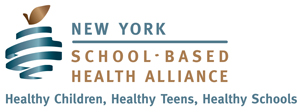
What are School-Based Health Centers (SBHCs)?
Students perform better when they show up for class healthy and ready to learn. School-based health centers (SBHCs) ensure that kindergarteners through high schoolers can get a flu shot, have an annual physical, have their teeth examined and their eyes checked, or speak to a mental health counselor in a safe, nurturing place – without the barriers that families too often face.
SBHCs exist at the intersection of education and health and are the caulk that prevents children and adolescents from falling through the cracks. They provide care – primary health, mental health and counseling, family outreach, and chronic illness management – without concern for the student’s ability to pay and in a location that meets students where they are: at school.
SBHCs may vary based on community need and resources.
Common Characteristics of SBHCs
- Located in schools or on school grounds.
- Work cooperatively within the school to become an integral part of the school.
- Provide a comprehensive range of services that meet the specific physical and behavioral health needs of the young people in the community.
- Employ a multidisciplinary team of providers to care for the students: nurse practitioners, registered nurses, physician assistants, social workers, physicians, alcohol and drug counselors, and other health professionals.
- Provide clinical services through a qualified health provider such as a hospital, health department, or medical practice.
- Require parents to sign written consents for their children to receive the full scope of services provided at the SBHC.
- Have an advisory board consisting of community representatives, parents, youth, and family organizations, to provide planning and oversight.
Principal Goals of SBHCs
1. The SBHC Supports the School
The SBHC is built upon mutual respect and collaboration between the school and the health provider to promote the health and educational success of school-aged children.
- Understands and respects accountability within the educational system.
- Works with the school administration to develop and achieve a shared vision.
- Communicates the vision to all school constituencies including teachers, support staff, students, and parents.
- Builds collaborative and mutually respectful relationships with school personnel.
- Identifies community resources that provide support to students and promote successful learning.
- Serves as a resource in times of school crises and community disasters.
2. The SBHC Supports the Community
- Assesses child and adolescent health care needs and available resources in the community through formal evaluation methods.
- Informs the community of student health needs and trends.
- Solicits community input to address unmet health needs and to support the operations of the program.
3. The SBHC Focuses on the Student
- Encourages the students to engage in active, age appropriate participation regarding health care and prevention activity decisions.
- Involves the parents or other adult caregivers as supportive participants in the student’s health care whenever appropriate and possible.
- Ensures confidentiality of information whether transmitted through conversation, billing activity, telemedicine, or release of medical records.
- Provides services and materials that are culturally sensitive and respectful of family values and diversity.
4. The SBHC Delivers Comprehensive Care
- Promotes availability of on-site services whenever the school is open and facilitates after-hours care 24-hours-a-day, seven-days-a-week.
- Adopts generally accepted guidelines for clinical practice.
- Promotes the interdisciplinary role and functions of the SBHC team.
- Coordinates and integrates efforts with existing systems to optimize complementary programs, improve continuity of care, reduce fragmentation, prevent duplication, and maintain affordable services.
5. The SBHC Advances Health Promotion Activities
- Serves as a resource to school administration on the selection, development and delivery of health education curricula.
- Participates in classroom-based and school-wide health promotion activities responsive to risk factors that are prevalent among students.
- Promotes parent and community involvement in health promotion activities.
6. The SBHC Implements Effective Systems
- Ensures compliance with all relevant laws and regulations.
- Develops and measures annual program goals and objectives.
- Maintains a physical plant which is adequate to deliver high quality services and assure patient comfort and privacy.
- Develops all necessary policies and procedures, training manuals, and memoranda of agreement or understanding.
- Develops a human resources system for hiring, credentialing, training, and retaining high quality competent staff.
- Collects, evaluates, and reports health outcomes and utilization data.
- Establishes quality improvement practices including but not limited to assessment of patient and community satisfaction.
- Develops strategies and systems to support long-term financial stability.
7. The SBHC Provides Leadership in Adolescent and Child Health
- Participates in national and local organizations that focus on adolescent and child health.
- Contributes to the body of knowledge on the health care needs of adolescents and children.
- Promotes the SBHC as a training site for health care professionals.
- Advocates for the resources necessary to increase access to physical, mental and dental health services for adolescents and children.
- Informs elected officials, policy-makers, health professionals, educators and the community-at-large regarding the unique value, acceptability, efficiency and convenience of the school-based health center model of health care delivery.
- Forms partnerships to develop stable and sustainable funding mechanisms for expanded services.
8. Regardless of school closures, SBHCs are readily available.
- Services are available via Telehealth as well.
